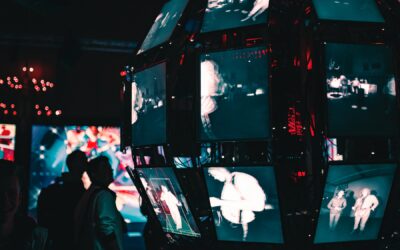The past year has seen hundreds of thousands of would-be office-goers retreat to the comfort, or discomfort, of their make-shift offices at home. The effects of the Coronavirus pandemic have been felt by businesses in all industries around the world. Separating teams have forced organizations to consider ways in which they can keep communication, collaboration, and team productivity as efficient as it had been in the office.
Technology has been one of the saving graces of the work from home era. From the power of telecommunications to the internet and video conferencing; it seems that most businesses have managed to transition from the office to WFH seamlessly. So much so, that many have set in motion plans to continue to work from home to some extent. This is regardless of the fact that work-from-home life incurs longer workdays and work-life balance takes a whack.
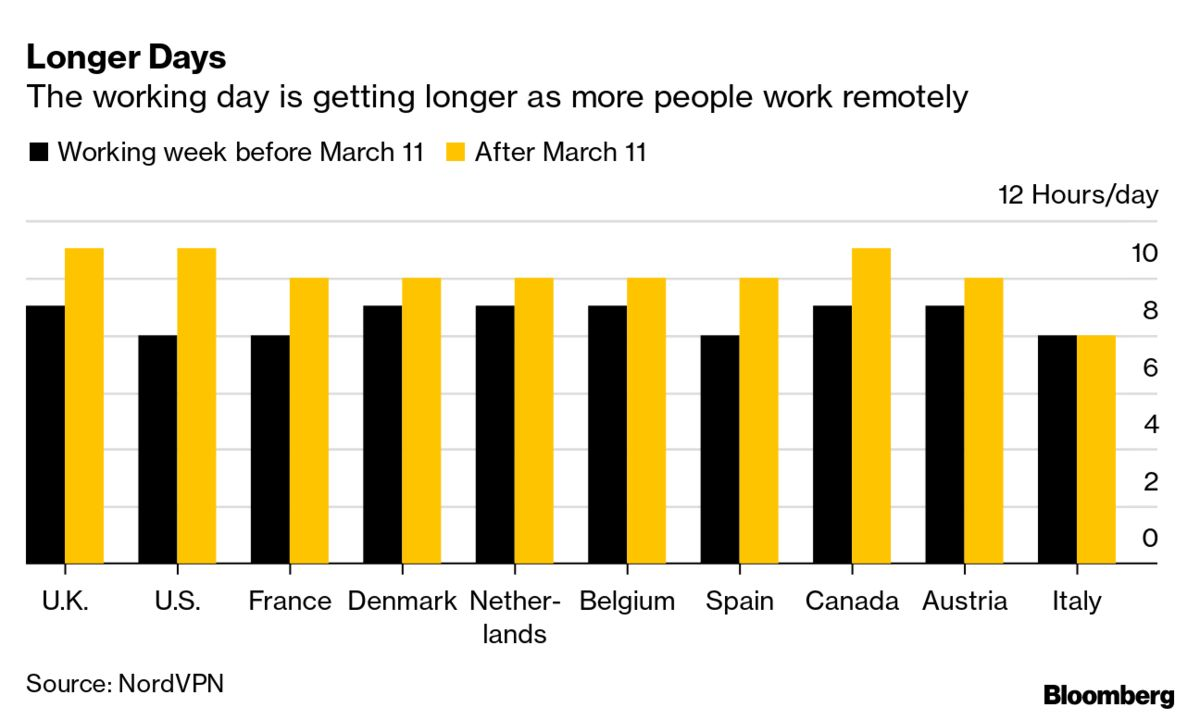
(Working day by hour pre and post March 11th, 2020. Image: Bloomberg)
Whilst the vastly applied technologies have enabled employees to continue to carry out their job functions, as well as allow for some form of face-to-face communication between employees and employers; there are still many features of the traditional office that contributed to a sound work-life balance. Consider the following.
- Workers commute – Commonly synonymous with rush-hour and a pain in the neck; the average hour spent commuting also played a key part in daily physical activity, and allowed for some time for self-reflection, to read, to listen to podcasts or to get ahead on the day’s work. Working from home removes the need to commute and as a result, eliminates the necessity to wake up an hour early, exercise, see and interact with other people, and reflect on the day ahead.
- Being a part of a team – For many, the office was home to their team and acted as a place where they could collaborate, share ideas, execute plans and reap the rewards of their efforts within the team. The physical office aided the sense of belonging and is an important symbol to employees of the company they work for. In the absence of a physical office, it can be hard for employees to remember the effects their position has on the wider team.
- Socializing – Escaping the mundane and repetitive nature of home-life to an office with social possibilities, and colleague lunches are fundamental to the wellbeing and morale of a team. A quick catch-up in the kitchen whilst making tea is all it takes to give an employee a boost of productivity.
- Training – On-the-job training is proven to be more effective both in terms of cost and value relative to textbook learning. Most employees value learning on the job since it’s a way to improve their skills and efficiencies. It encourages career progression and retainment of employees for organizations. The transition to WFH has eliminated most traditional training methods and has made onboarding new employees difficult – to say the least.

(Reported problems faced working from home. Image: ZDNet)
The power of virtual reality
As technology evolves, so too does the capacity of companies to work more efficiently. From communications to production, sales, and marketing; technology has drastically improved the relationship between client and company by furthering the reach and scope of instant and effective communication. More recently, the emergence of Virtual Reality (VR) has introduced the possibility of virtually taking any office anywhere.
In terms of business efficiencies, VR has a role to play in every conceivable department of an organization. The power of VR enables organizations to create customizable VR content to accommodate every need. When it comes to working from home, VR companies like Mesmerise can make employees feel every sensation of being back in the office.
Virtual reality, as a computer-generated simulation of a 3-D environment, can be interacted with in a seemingly real and physical way by a user immersed in the virtual realm using special VR compatible equipment, including a headset or helmet with a screen inside, and gloves fitted with sensors.
How does it work?
First and foremost, the subject of virtual reality is simulation the vision. Vr headsets aim to perfect an immersive 3D environment. Typically, a VR headset will put up two screens – on for each eye – in order to completely eliminate any interaction with the real world. Autofocuses lenses are placed between the screen and the eyes that adjust based on individual eye movement and positioning. The content is rendered by using a mobile device or HDMI cable that is connected to a PC.
The science behind VR is what separates the experience from augmented reality and other emerging technologies. To be a truly immersive VR experience, the frame rate must be a minimum of 60fps. This is the rate at which the GPU can process the images per second. An equally competent refresh rate is also needed, as well as a minimum of a 100-degree field of vision – this is the extent to which the display can support eye and head movement.
Failing to meet these minimal prerequisites makes for a weak VR experience and can cause the user to experience latency – which is too much of a time gap between their own actions and the response from the screen. Inconsistency between the frame rate and the refresh rate can also cause cybersickness. This is clearly incompatible with an eight-hour workday when considering using VR to replicate an office environment. With that said, however, the power of VR certainly holds promising applications for mimicking an office-like experience during WFH.
VR meeting spaces
As a result of the covid pandemic, people all over the world have been forced to work from home in an attempt to stop the spread of the virus. The strategy seems to work, but has been truly disruptive to the ways in which we communicate with our colleagues to ensure continued performance.
In the absence of physical meeting space to collaborate, communicate and hold meetings and discussions; many have turned to video calls and have contributed to the Zoom – boom. Virtual reality, however, offers a stronger alternative to video calls, and those who adopt it are likely to maintain virtual communications as a long-term strategy – long after the Pandemic.
One of the biggest strengths of virtual reality is its ability to make people feel like they are in fact within the same space with their colleagues. There’s no need to travel into the meeting space, in fact, people from across the world can tap into a VR meeting space to join their colleagues as if they were in the same room. This is clearly better for the environment, as well as better use of time and budget.
Such virtual reality meeting environments can be customized to mimic the exact layout of a real office or can be elevated to new heights for optimal creativity. Gather the team, and place them in a thought-provoking room overlooking the Himalayan mountains, for example. The VR content should be designed for optimal productivity and creativity.
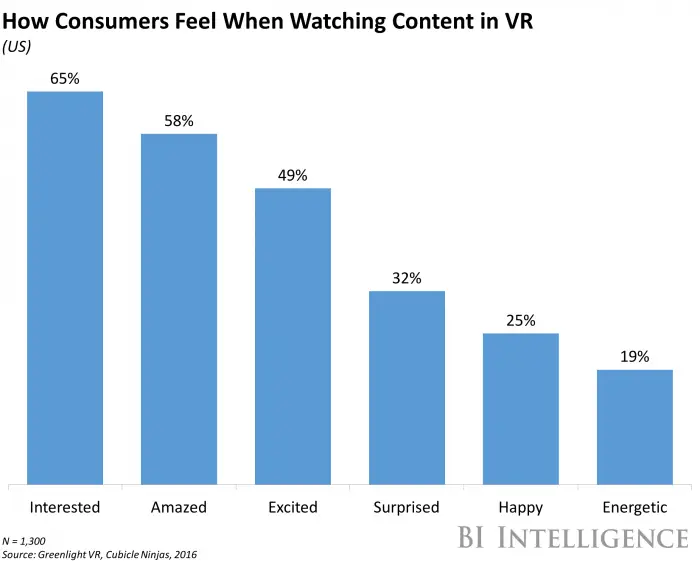
(How consumers feel when watching VR content. Image: Business Insider)
VR clearly taps into the emotional range of its viewers. It prompts feelings of interest and amazement as well as keeping consumers happy and energetic. When it comes to working from home, these feelings can fill the void left behind in the office.
Team vibes with VR
For centuries now, the telephone has been a tremendous way to keep in touch, but it’s simply no replacement for face-to-face contact. In any given conversation, a lot of information is non-verbal communication. Whilst video calls allow for a better understanding of a person’s facial expressions, all non-verbal cues can be transcribed in virtual reality.
Clearly taking in a person’s tone of voice, hesitations, hand-gestures, and head movements all improve the understanding of the person’s emotions and intents. VRs capacity to bring people together in a 3D environment can enhance communication by overcoming linguistic barriers as well as technical jargon.
VR has the upper hand when it comes to the next best thing – video calls. That’s because VR situates all participants in the same virtual space. As a result, each person can share ideas and work together in a truly collaborative way in real-time. VR technology also allows users to import custom environments or 3D objects, or work together on virtual whiteboards to ensure that everyone is taking part. One of the best things about this space is that it can be revisited by participants to better understand, record, and process the VR content.
It’s been reported that there is a 25% increase in attention span when meeting in a virtual reality room, compared to video conferences (Forbes). This is probably because there are far fewer distractions since the user is totally immersed in the virtual world. In addition to this, research suggests that people retain more information and can better apply what they have learned after participating in VR. This is key for briefings, management-led conferences, and employee reviews.
How close can VR versions of employees get to the real thing?
Arguably one of the biggest downsides to VR is that the current use of avatars within VR meeting spaces is visually relatively simple. The computer-generated characters that represent us in these VR spaces lack human form and sophisticated virtual capabilities. This is simply down to the technological constraints that now exist.
Looking ahead, however, Facebook appears to be making strides when it comes to modifying the capabilities of the VR avatars that represent us. So much so, that soon, the virtual characters will be so similar to our real selves that it should, in theory, feel like you’re looking into a mirror.
The Director of Facebook Reality Labs confirms that the real promise of VR is that instead of flying in to meet someone in person, all they have to do is pop on a headset and enter the virtual reality meeting space, whilst looking, moving, and sounding the way you do (The Verge). Should VR ever live up to this promise, it would seem that VR has the capacity to get incredibly close to recreating sophisticated digital versions of employees to represent them in the VR space.
VR collaboration
Much like the prospects of the VR meeting space for general discussions, briefings, and social meetings; VR can also bring people together from all over the world, under one digital roof, to physically collaborate on projects, prototypes, practices, and procedures. The ability of VR to generate real-size scales of any object, and allow people to manipulate it, change it, rotate it, and walk around it; allows for a truly immersive collaborative experience.
To what extent do you agree that VR could lead to better collaboration in the workplace
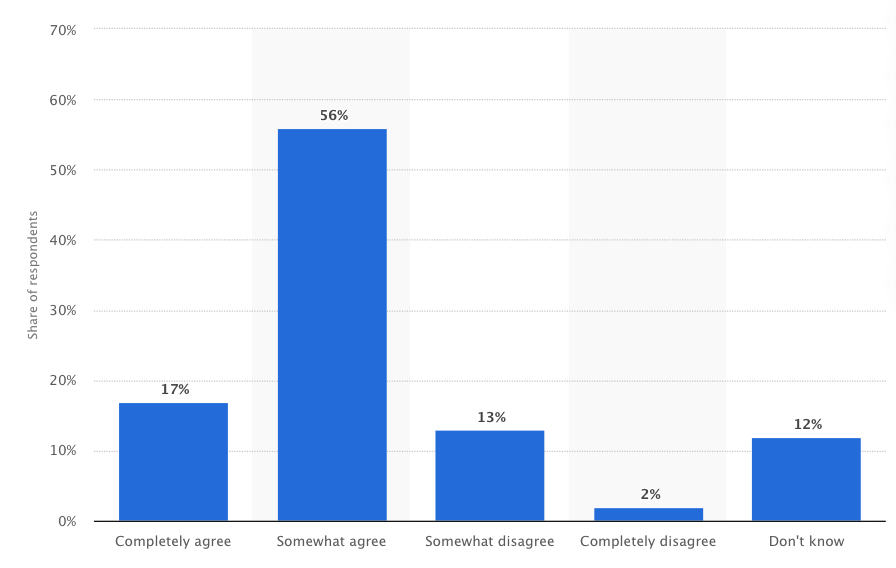
(Opinions on VR collaboration. Image: Statista)
When the work from home period constricts everyone to their own homes, there is simply no alternative to VR in helping them virtually escape and come together to collaborate. Organizations can use VR in product development, iterations and workflows to prevent delays with product launches and to optimise products before they are launched.
Remote collaboration tools can help businesses overcome the absence of employees from offices by providing opportunities to meet, discuss, present, and make collective decisions virtually. Projects are now being managed from start to finish in the virtual world with VR collaboration tools. The unique virtual space enables team members to meet, train and host events in order to mind map ideas together. A range of tools is being put to use to make this possible, including VR headsets, and mobile devices – each of which makes remote collaboration accessible and affordable. This is particularly true when you consider the costs associated with bringing together remote teams from all over the world.
Workflows in a VR environment
VR is undeniably revolutionising workflows every minute of the day. This is particularly the case when it comes to product development and as VR software becomes more accessible. Multiple remote teams can now work in the same space simultaneously on virtual prototypes long before they are ever produced in the real world. VR enabled product developers to create multiple iterations of 3D models at speed – from their homes.
Thanks to the coronavirus pandemic, we now know that remote work actually works. Better yet, VR makes the processes in research and development faster and more cost-efficient than would be possible if team members were required to attend a physical workspace. The development stage of a products life cycle would traditionally involve multiple meetings across different departments to discuss, model and pitch their ideas.
Thanks to VR, research and development teams now have all the tools they need to monitor and offer feedback at speed and remotely. The best part of this emerging technology is that you don’t have to be a tech guru to invest in VR for your remote teams. The soft skills associated with using VR are imperative for all employees, given how fast society is gravitating towards the everyday applications of virtual reality and augmented reality (AR).
VR data visualisation at home
The 360-degree capacity of VR doesn’t stop at exploring surroundings and interacting with the environment around you. Rather, it has the ability to transform the 2-D into 3-D. Virtual reality as a data visualisation tool allows organisations to create multidimensional, high-fidelity models for complex data sets and make them easy to understand for all users. VR discourages data being left untapped and rather allows for a broader, more detailed picture of what the data displays.
Visualising big data is game-changing the financial sector in particular. The financial industry has a reputation for demanding long hours in the office and spending hours on end in front of data sets. Bank of America has already adopted VR to provide visualisations of data for their employees (Business Insider). One of the only caveats in this industry is that VR hardware is regarded as bulky and uncomfortable. Companies are proactively working on refining the hardware to enable long-hours of usage at ease. Should the work from home period last much longer, the technology is likely to find its place on the kitchen table work-station of traders and consultants sooner than we think.
Visualising data together with VR
Beyond the limitless presentation formats, VR enables a far more user-friendly way to analyse and understand data. The ability to visualise data in 3-D from multiple viewpoints can help users discover trends, patterns and anomalies that would be impossible to detect using spreadsheets and charts. VR enables users in different geographical locations to come together to analyse data and share thoughts. Just as in the office, where employees might find themselves gathered around a single screen in an attempt to decipher complex data – they can move around a more understandable model of the data together in a VR space.
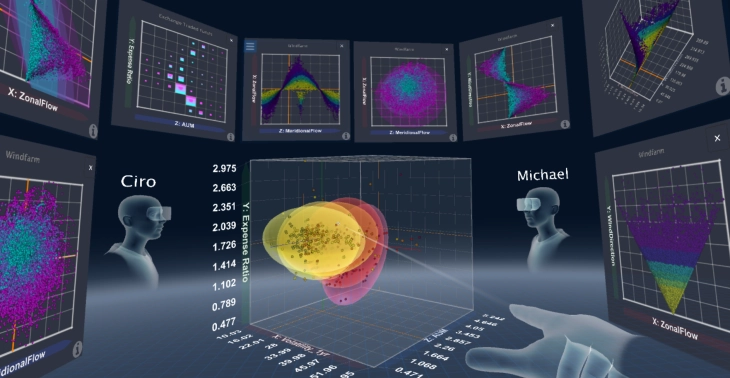
(Data visualisation platform. Image: TechCrunch)
The importance of visualising data in 3D stems from the fact that we live in a 3-dimensional world where we perceive 3D objects as a natural part of life. VR data visualisation contributes to the ease of data understanding as well as retention.
This hands-on experience with data prompted NASA to adopt VR for its galaxy exploration pursuits in 2019. Astronomers were tasked with classifying star groups together but effectively failed to reach a collective decision. They abandoned their traditional paper graphs and decided to visualise the speed and direction of the stars in the Milky Way space in virtual reality. They used the PointCloudsVR platform to do so and easily spot stars, making their classification easier, faster and with fewer mistakes.
Remote Data visualisation
Viewing data through VR on a 3-D basis comes into particular use today when so many employees who traditionally handle data are working remotely. Through VR, data scientists, marketers, consultants, traders, and the like, can come face-to-face with their colleagues to hold focused discussions by eliminating the distractions at the at home workplace. It also removes the communication lags of video conferencing and miscommunications in messaging.
An example of using data virtually in a remote setting can be found when we look at a team of researchers from the Columbia University Vagelos College of Physicians and Surgeons, who were conducting research on the correlation between flu epidemics and cancer mortality. The group used the Virtualitics Immersive platform to analyse their findings. It’s advanced virtual presentation features allowed for stringent real-time teamwork. Virtual collaboration allowed the group to discover the correlation between the mortality rate of cancer patients and flu severity.
Pitching and presenting remotely with VR
Perhaps of all the capabilities of VR in recreating the office environment, none other is more needed than the ability to pitch and present remotely. As more and more companies face financial strains as a result of the closure, they will have to get their ideas and demands out in front of key stakeholders and investors effectively.
VR tools enable users to improve their chances of avoiding ambiguity and misunderstanding when communicating complex information to stakeholders. Traditional tables and graphs of financial information, or images and videos of new product lines may well have had their place in the presentation process; today virtual reality improves the effectiveness of any pitch, making it more digestible, engaging and convincing.
Making pitches more compatible with working remotely, in virtual reality, you can also add additional explanatory material, by way of images, texts, videos and opinion polls to your presentation. Of which, viewers can access any time with simple hand controller manipulation. The level of interaction makes for an engaging and exciting experience for stakeholders, meaning the presentation is likely to stand out against others, and resonate with your audience.
Augmented reality is similarly useful in this case. IBM introduced Immersive Data, which is an AR-powered exploration tool that allows users to explore data in more interactive ways. It blends the physical and virtual worlds together and displays sophisticated data sets in 3-D. These can then be demonstrated to stakeholders, who can use AR headsets to view, interact with and manipulate the virtual display of data. Virtual reality takes things a step further by fully immersing users into the virtual world where they can interact with the data in any chosen setting.
The VR office experience in a nutshell
It’s apparent that the capabilities of virtual reality are so vast that they do indeed have the capacity to recreate and mimic an office-like experience. From bringing remote teams together into a virtual space to enabling effective remote collaboration on any given project. As the technology evolves and VR avatar representations become more like the physical users; the gap between the real and virtual realities close in. When the immersive headset comes off, employees are free to continue with their day- avoiding rush hour and allowing for a better work-life balance.






